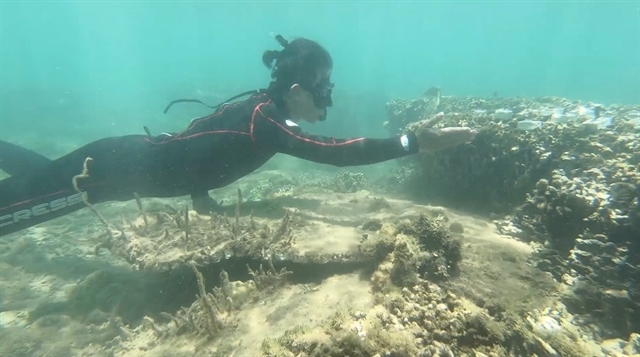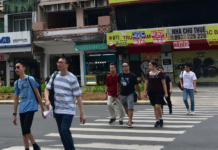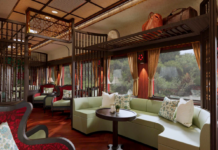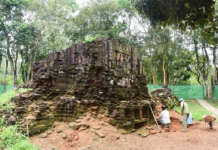
Efforts to revive the local coral population on a 1.2-sq.km patch of dying reefs began in 2016.
Six members managed to grow 100 to 200 coral branches on the reefs each day, and 1 million coral plugs were used to restore between 100 and 200sq.m of coral in waters to the south of Son Tra.
“We grafted coral branches on already damaged base coral and cleared away plastic waste and pollutants,” said team leader Le Chien. “Free diving allows us to work at depths of 15 to 20 metres.”
“The reefs have been damaged by plastic waste and pollutants, and we also clear away fishing nets and other waste.”
“Ghost nets” — inadvertently lost overboard by fishermen and drifting around underwater — are a major danger to coral, as is plastic waste.
“Plastic bags and ‘ghost nets’ get caught up on coral and allow moss to grow, which starve the coral of oxygen,” he explained. “Anchors and the use of electric shocks or explosives in fishing, meanwhile, destroy the coral completely.”
Coral and seaweed, are seen as key factors in limiting climate change, given their high carbon absorption capacity and abundant nutrients for other life underwater, according to Chien.
Coral reefs no more
Old fisherman Phan Liem, 83, remembers a 20-km coral reef here long ago, but it was excavated after 1975 to build lime kilns producing construction materials.
“Coral reefs create a ‘safety zone’ that makes for bumper fishing,” he said.
“Fishing reserves have gradually dropped away over the course of the last few decades, as the coral has gone. The reefs also acted as a natural protective wall against storms and coastal erosion.”
According to the Southern Institute of Ecology, the waters off the coast of Da Nang were previously home to 104ha of coral reefs, 26ha of seaweed, and 10ha of sea grass, but large swathes of coral and seaweed have either been significantly damaged, destroyed or even disappeared.
Vuong Thuy Hanh, a female member of the team, said coral rescue was a risky business and involved taking on big waves, underwater currents, and the sharp edges of the coral.
“We were pleased to find that the coral the SaSa team planted survived last year’s storms,” she said. “Many volunteers from Hanoi and HCM City have also come to work on coral restoration.”
“The task requires sustainable management in boosting tourism while conserving marine species, and fishermen should be educated on the best way to fish and the importance of marine animals.”
She suggested that funds be allocated for ocean conservation and protection, as volunteers can only do so much.
Another volunteer, Nguyen Chi Dung, who knows a thing or two about metal fabrication and construction, joined the effort after meeting the team founder in 2017.
“I now manage a bar in Hanoi but always try to find the time to work with the SaSa team for a few days,” he said.
“I designed the base for the coral plantation and other construction-related works both underwater and on the beach.
“It kept me busy for eight months straight before I took a one-month break, then three months later I was back with the SaSa team.
“I was anxious for the coral, as the reef has been heavily damaged by plastic pollution and careless fishing techniques. People refusing to use plastic bags would go a long way towards curbing the amount of plastic pollution off Vietnam’s coast.”
Meanwhile, Corentin Chx, who hails from New Caledonia, a small French island near Australia, began working with SaSa three years ago after seeing a Facebook post.
“I didn’t know there was such an organisation in Da Nang and wanted to help rescue one of the biggest coral structures in Son Tra,” he said.
“I then became a key member of SaSa, supporting the team and introducing more volunteers at events and activities. We planted more than 100sq.m of coral thanks to sheer hard work.
“Balancing my volunteer work in the morning with a night job managing a bar was a bit of a strain.
“I exhausted myself but it was worth it. I was given the Vietnamese name Le Van Bien and have been one of the longest-serving foreign volunteers. We try to help what has been destroyed and restore it if we can. It’s risky work, and I’ve been injured a few times pushing the limit during a dive.”
Future solutions
Volunteers with the SaSa team have spent a lot of their own money and days or evens months of time trying to rescue the coral and other marine species.
More than 200 volunteers from Da Nang, Quang Nam, Quang Ngai, Nha Trang, and Phu Quoc Island are part of the team’s ocean revival campaigns, which include cleaning up the coastal environment, planting and protecting coral, and monitoring newly-grown coral.
They have also rescued at least eight dolphins and turtles stuck in nets just off the coast.
Team leader Chien hopes to establish marine education centres to teach school students and young people about preservation.
“We plan to install manual plastic waste processors along the beach, where local residents and tourists can grind up their plastic bottles for recycling rather than dumping them in a garbage bin or in the water,” he said.
“Portable plastic waste processors are easy for fishermen to use on long trips, and they could earn money from recycling waste they come across.
VNS



